
- North Rim
- History
- West Rim
- Grand Canyon National Park
- Grand Canyon
- Facts
- Grand Canyon Railway
- Hualapai Tribe
- South Rim
- Wildlife
- Shoshone Point
- Yavapai Geology Museum
- Hermit's Rest
- Hopi House
- Plan Your Visit
- Timings
- Directions
- Entrances
- Restaurants
- Map
- Camping
- Grand Canyon Village
- Weather
- Photos
- Hiking
- Things to Do
- Viewpoints
- Shopping
- Itinerary
- Hotels
- Rim to Rim
- Grand Canyon Floor Landing Tours
- Grand Canyon Lake Mead Tours
- Grand Canyon West Rim Tours
- Grand Canyon National Park Tours
- Grand Canyon North Rim Tours
- Las Vegas to Grand Canyon Helicopter Tours
- Grand Canyon Tours from Las Vegas
- Grand Canyon Airplane Tours
- Grand Canyon Helicopter Tours
- Grand Canyon South Rim Tours
- Grand Canyon Boat Tours
- West Rim Skywalk
- Grand Canyon National Park Helicopter Tours
- Grand Canyon Hummer Tours
- Grand Canyon West Rim Helicopter Tours
- Grand Canyon Tours
- Helicopter Tour Operators
Everything you need to know about the Grand Canyon | Geology, biodiversity, and its people
Overview

The Grand Canyon is a steep-sided canyon in the southwestern part of the Colorado Plateau, with the Colorado River sculpting its many layered ranges and sections. It’s located in Arizona, United States. It extends from the northern part of Arizona, near Lees Ferry, and shares its boundary with the state of Utah, to the Grand Wash Cliffs, near the Nevada state line. The total length of the canyon is 277 miles (446 km).
Grand Canyon is divided into three rims, split into two main sections under the Grand Canyon National Park and Grand Canyon West.
- Grand Canyon National Park (South Rim): The South Rim is the most visited area in the Grand Canyon due to its many viewpoints, hiking trails, cultural activities, tours, and experiences. It’s open to visitors throughout the year.
- Grand Canyon National Park (North Rim): The North Rim is the more remote part of the National Park and is open for tours and experiences from mid-May to mid-October. It offers great trails, views, and a chance for deeper exploration of the canyon.
- Grand Canyon West (West Rim): The West Rim is a popular day trip choice for those visiting from Las Vegas since it’s a short 2.5-hour drive away. There are multiple viewpoints at the West Rim, as well as the famous Skywalk, zipline, boat, and helicopter tours that offer a unique experience of the canyon.
Geology, hydrology, & formation

Geology
The geology of the Grand Canyon is complex and layered, just like its rock formations. The inner gorge of the canyon, made up of igneous and metamorphic rocks, is around 2 billion years old. Right above these lies a layer of sedimentary limestone and sandstone rocks that are approximately 540 million years old. Over these layers of sandstone, limestone, and freshwater shale deposits that form much of the canyon’s walls took place during the Paleozoic period, which stretched over 300 million years. Then, the final Colorado Plateau uplift took place between 70 and 30 million years ago, forming the Colorado Plateau region that resulted in the eventual formation of the Grand Canyon.

Hydrology
The Colorado River is the main force behind the formation of the Grand Canyon. It began over 5 to 6 million years ago, and the river’s trajectory and velocity at which it continued flowing downstream is what carved the canyon and formed its gorges, pathways, and walls. Besides the river, there is also groundwater flow from different sections of the rock formations in the canyon. Research conducted to study the groundwater in the canyon has observed that there is a mix of modern water as well as old water present in the system. The ages of the South Rim groundwater emerging from the springs were found to be 6 years old and over 10,000 years old!
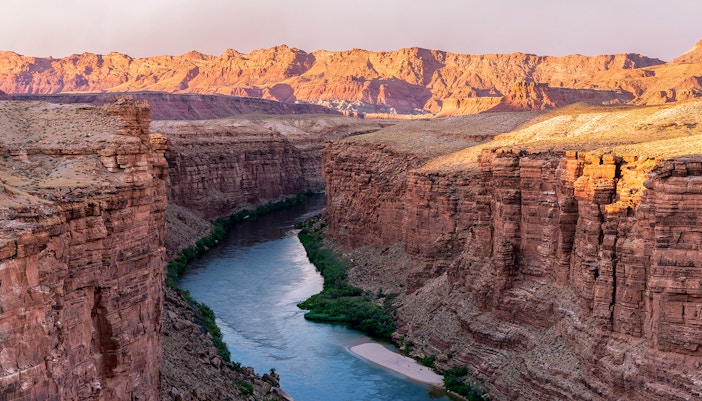
Formation
The tectonic uplift in the region that took place created the setting for the formation of the Grand Canyon. The elevation of the Colorado Plateau was high enough for the Colorado River to flow downward at an incredible speed, downcutting the plateau and carving the canyon. Millions of years of high-velocity flow of the river led to flooding, intense bouts of erosion, and the creation of deep entrenchments. The reason for the size of width of the canyon is also the rain, winds, and arid temperature, causing the soft sedimentary rocks of the canyon’s walls to break apart and widen the paths.
Grand Canyon sections explained
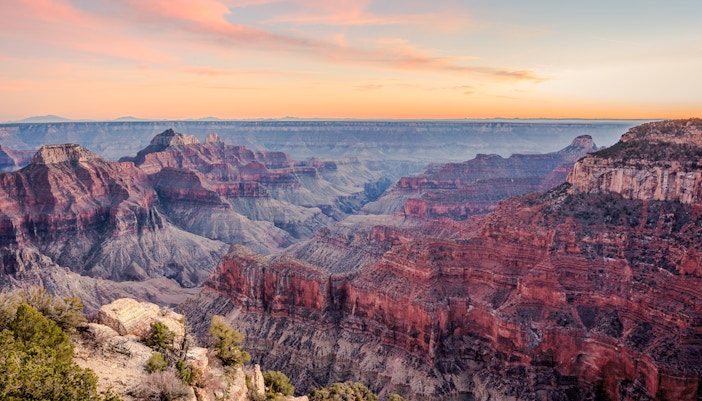
North Rim (Grand Canyon National Park)
The North Rim is a much cooler and more secluded region of Grand Canyon National Park. It’s at an elevation of around 8,000 feet and is open seasonally from mid-May to mid-October 15. The visitor center operates daily from 8am to 4pm during this period. The North Rim offers some of the most breathtaking panoramic views of the canyon at points like Bright Angel Point and Cape Royal.
Popular activities include hiking the North Kaibab Trail, which leads into the canyon, and attending ranger-led programs. The higher elevation at the North Rim leads to more rainfall, creating a greener landscape compared to other parts of the canyon. The unique flora, such as dense pine forests, and fauna, including mule deer and various bird species, add to its novelty.
More about North Rim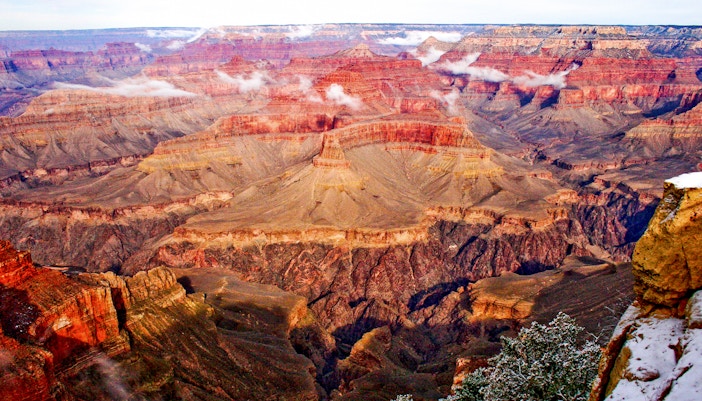
South Rim (Grand Canyon National Park)
The South Rim is the most accessible and frequently visited part of Grand Canyon National Park. It is open to the public all year round, 24 hours a day, but the visitor centers are only open from 9am to 4pm. Popular activities include exploring the Grand Canyon Village and visiting viewpoints like Mather Point and Yavapai Point. The viewpoints offer some of the most iconic views of the Grand Canyon, making it a popular destination for photography and sightseeing.
The South Rim is also home to significant cultural and historical sites, such as the Desert View Watchtower. Visitors can explore the Yavapai Geology Museum to learn more about the canyon’s formation. There is lodging, restaurants, and a free shuttle bus system, and parts of the South Rim are also wheelchair-accessible, making it an ideal choice for first-time visitors.
More about South Rim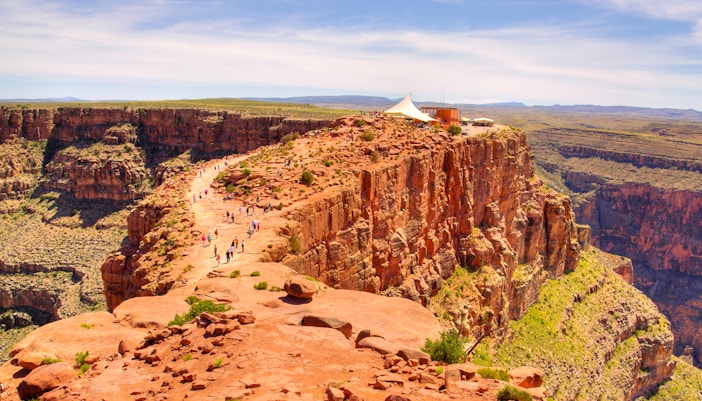
West Rim
The West Rim, managed by the Hualapai Tribe, is close to Las Vegas (128 miles, 206 km), making it a popular choice for visitors from Nevada. The West Rim is open daily from 8am to 6pm. The landscape here is more arid and rugged, giving it a distinct appeal for those looking for a different Grand Canyon experience.
One of the main highlights at the West Rim is the Skywalk, a glass bridge that extends over the canyon, offering a panoramic view of the canyon and the Colorado River below. Visitors can also visit Hualapai Ranch to learn about Hualapai traditions.
More about West RimWeather & climate
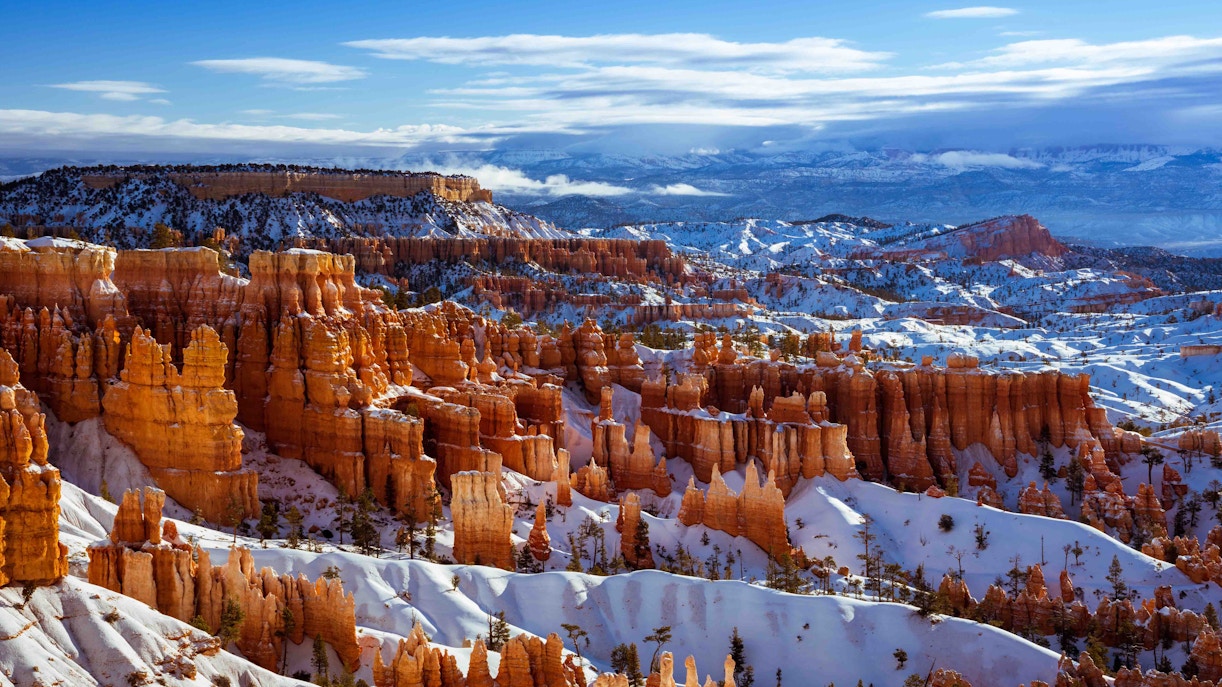
The Grand Canyon has a varied climate depending on the rim, season, and elevation levels.
- North Rim: Winter months (December to February) are the harshest in the North Rim, with heavy snowfall leading to closures. Temperatures drop to below-freezing levels. Summer months are the most pleasant at the North Rim with temperatures ranging from 60°F to 70°F (15°C to 25°C), but the region experiences heavy rain and thunderstorms in the monsoon season. September onward, the temperatures begin to drop again, and the area gets its first snowfall in October.
- South Rim: The South Rim experiences snowfall in winter, but not as heavily as the North Rim. The harshest weather conditions occur during the summer months, from June to August, with sudden thunderstorms, strong winds, flash floods, and temperatures reaching 90°F (32°C) during the day. The weather in spring and fall is pleasant.
- West Rim: It rarely snows in the West Rim, but there are strong winds. Temperatures begin to rise from March, at 80°F (27°C), and exceed 100°F (38°C) in the peak summer months, from June to August. Thunderstorms are brief and heavy, but there are dust storms.
Biodiversity in the Grand Canyon | Highlights
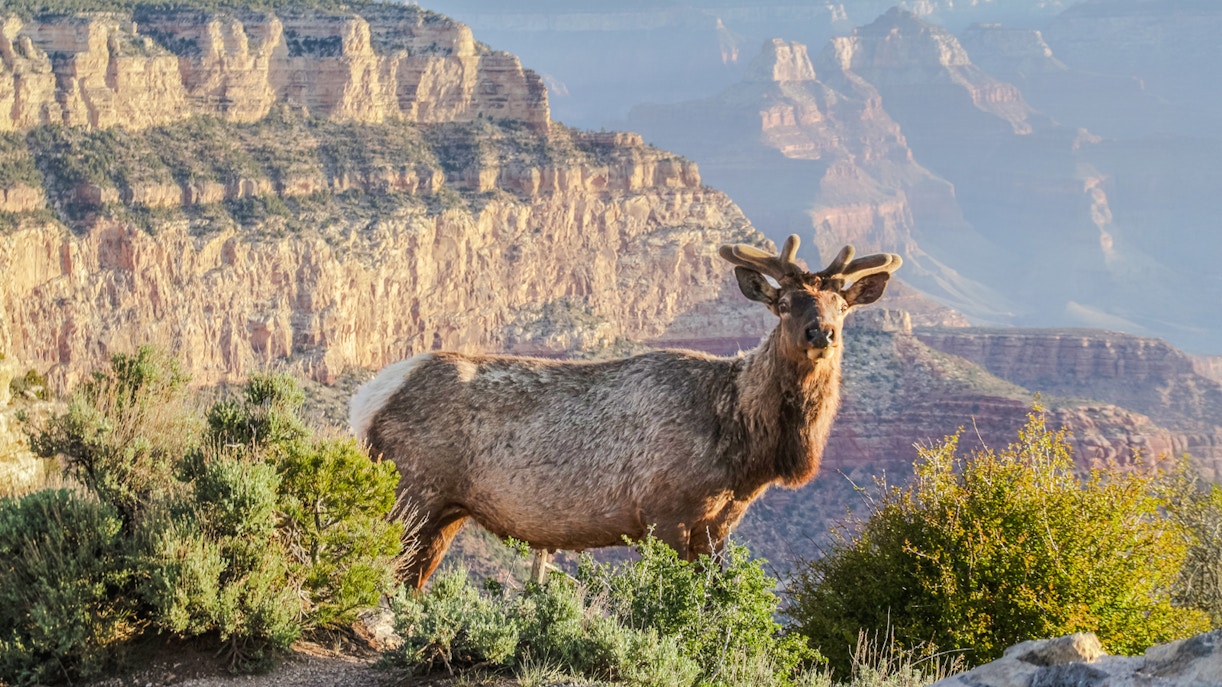
The Grand Canyon is home to a diverse range of plant and animal life because of its drastic variation in elevation levels and climate conditions. This combination creates distinct ecological zones across the three rims, from lush forests to arid desert landscapes that support a variety of species.
- Flora: There are around 1,737 known species of vascular plants, 167 species of fungi, 64 species of moss, and 195 species of lichen found in Grand Canyon National Park and surrounding regions.
- Birds: The Grand Canyon is home to 450 species of birds, with 250 bird species found along the Colorado River corridor.
- Fauna: You can find 91 species of mammals, 58 species of reptiles and amphibians, 18 species of fish, and 1,443 species of invertebrates. Many of these are endangered, rare, and endemic species.
A brief history of the Grand Canyon
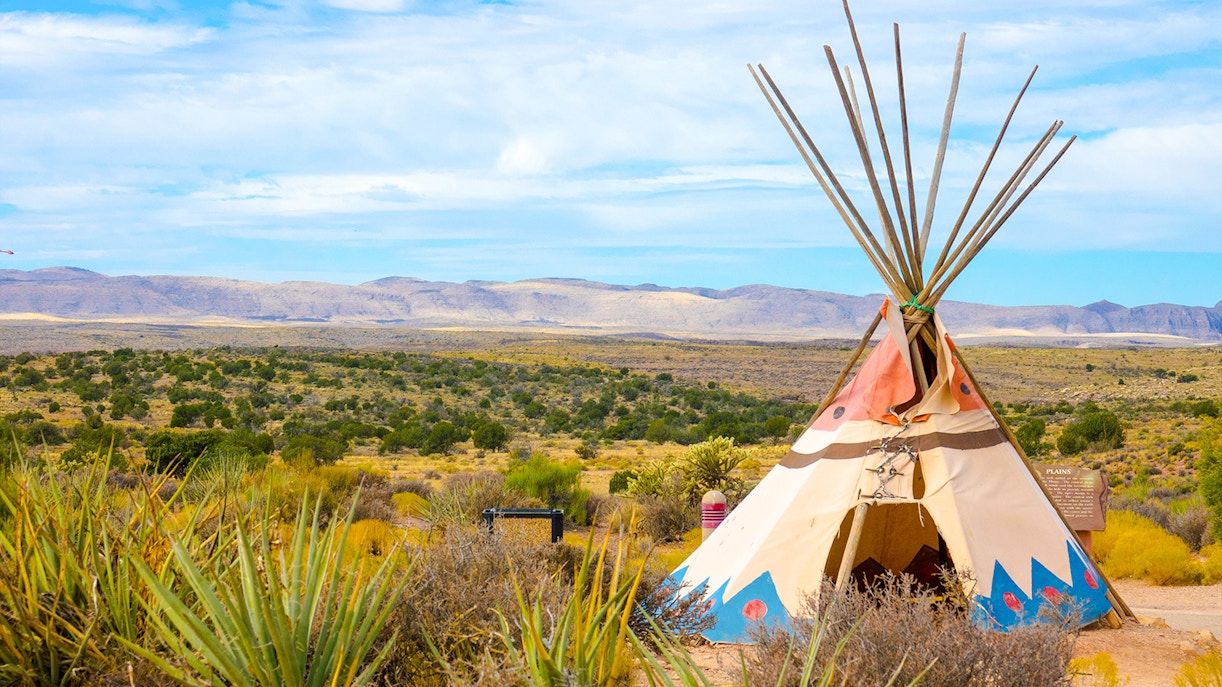
- 1200 BCE - 1500 CE: The Ancestral Puebloans (Anasazi) inhabit the Grand Canyon region, building dwellings and leaving behind pottery, tools, and petroglyphs.
- 1500s - Present: Native American tribes, including the Hopi, Havasupai, Navajo, Paiute, and Hualapai, continue to live in and around the Grand Canyon.
- 1540: Spanish explorer García López de Cárdenas becomes the first European to see the Grand Canyon.
- 1869, 1871-72: Major John Wesley Powell leads two expeditions gathering scientific data about the region and develops maps of the Grand Canyon.
- 1880s - 1919: Prospectors and miners establish mines across the Canyon for valuable minerals like copper and uranium.
- 1893: President Benjamin Harrison designates the Grand Canyon as an official Forest Reserve to protect its natural beauty.
- 1908: President Theodore Roosevelt declares the Grand Canyon a National Monument under the Antiquities Act.
- 2000: President Bill Clinton designates additional federal land as the Grand Canyon-Parashant National Monument to prevent mining and land development.
Book Grand Canyon tours
Frequently asked questions about the Grand Canyon
The Grand Canyon is more than a natural wonder; it’s also a vital site for scientific research, particularly in geology and ecology. It also holds deep cultural and spiritual significance for many Indigenous tribes, including the Hopi, Navajo, and Havasupai peoples.
Popular viewpoints on the South Rim include Mather Point, Yavapai Point, Desert View, Hopi Point, Toroweap Overlook, and Cape Royal on the North Rim, and Eagle Point and the Skywalk on the West Rim. Each offers breathtaking panoramic views of the canyon.
Yes! The Grand Canyon was designated a UNESCO World Heritage Site in 1979 due to its unique geological formations and incredible biodiversity.
Native American tribes, including the Ancestral Puebloans, were among the first known inhabitants of the Grand Canyon. Today, several tribes, including the Havasupai and Hopi, continue to have cultural and spiritual connections to the canyon.
Yes! Due to its immense size, the Grand Canyon is visible from space, making it one of Earth’s most recognizable natural landmarks.
Yes, the Grand Canyon’s rock layers contain fossils that date back hundreds of millions of years, including ancient marine creatures, early amphibians, and even prehistoric reptile tracks.
Explorer Major John Wesley Powell, who led the first official expedition through the canyon in 1869, is credited with naming it the "Grand Canyon."
Yes, the Yavapai Geology Museum, located on the South Rim, offers exhibits on the canyon’s geological history, fossils, and formation.
The South Rim is the most accessible and visited part of the canyon, featuring more facilities and viewpoints. The North Rim is higher in elevation, less crowded, and offers a more secluded and adventurous experience.
The Grand Canyon Skywalk is a glass-bottomed observation deck that extends over the canyon’s edge at the West Rim. It provides panoramic views 4,000 feet above the canyon floor.
Yes, but removing any artifacts is strictly prohibited. Archaeologists continue to uncover ancient pottery, tools, and petroglyphs left by Indigenous cultures.
In addition to the canyon itself, notable landmarks include Bright Angel Trail, Phantom Ranch, Horseshoe Bend, and the Desert View Watchtower.
Yes! Many Native American tribes have legends about the Grand Canyon. The Hopi, for instance, believe the canyon is a gateway to the afterlife, while the Havasupai have stories of their ancestors emerging from the canyon walls.
Yes, erosion from rainfalls, flash floods, wind, water, and rockslides continues to shape the Grand Canyon, making it a constantly evolving landscape.


